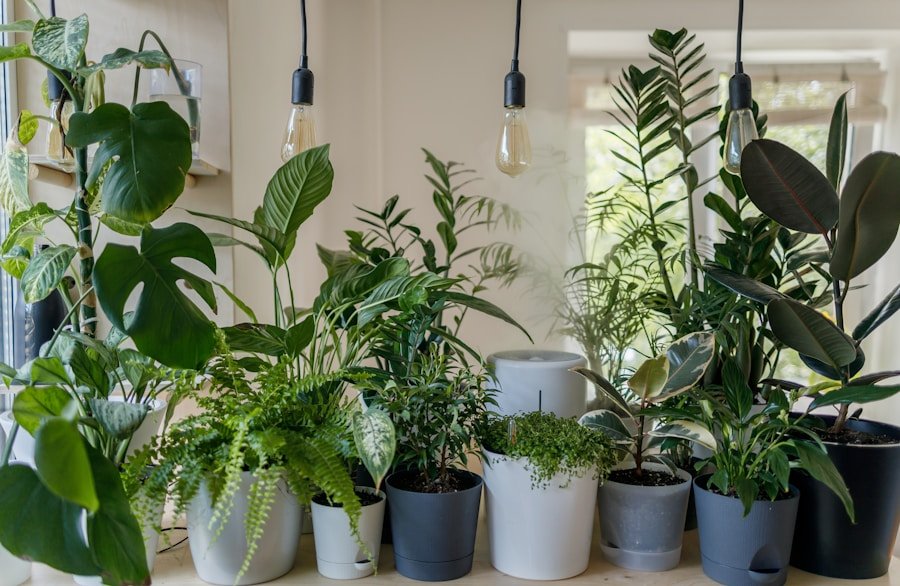When indoor plants begin to exhibit signs of decline, it can be discouraging. Common indicators of a struggling indoor plant include yellowing or browning leaves, wilting, stunted growth, and a general lack of vitality. These symptoms can be caused by various factors, such as improper watering, insufficient light, or poor soil quality.
It is essential to recognize these signs and take prompt action to rescue your indoor plants before they deteriorate further. In addition to observing visual signs, it is crucial to monitor the condition of the soil and roots of your indoor plants. Soil that is excessively dry or waterlogged, or roots that are rotting or compacted, are all indicative of plant distress.
By being vigilant and taking proactive steps, you can help revitalize your indoor plants and ensure they continue to flourish in your home.
Key Takeaways
- Signs of a dying indoor plant include yellowing or browning leaves, wilting, and stunted growth.
- Causes of indoor plant decline can include overwatering, underwatering, poor soil quality, and inadequate light.
- Revive your indoor plants by trimming dead or yellowing leaves, repotting in fresh soil, and adjusting watering and light levels.
- Choose the right soil and pot for your indoor plants by selecting well-draining soil and pots with drainage holes.
- Proper watering and drainage are crucial for healthy indoor plants, so water only when the top inch of soil is dry and ensure pots have adequate drainage.
Understanding the Causes of Indoor Plant Decline
Watering Issues
One of the most common issues that can contribute to the decline of indoor plants is improper watering. Both overwatering and underwatering can lead to stress and decline in your plants.
Poor Environmental Conditions
In addition to watering issues, poor soil quality, inadequate light, and low humidity can all contribute to the decline of indoor plants.
Root Bound Plants
Another common cause of indoor plant decline is root bound plants. When the roots of a plant become overcrowded in their pot, it can lead to stunted growth and a decline in overall health.
Taking Proactive Measures
It’s important to understand the specific needs of each type of plant you have in your home and provide the appropriate care to ensure their health and vitality. By repotting your indoor plants as needed and addressing these common issues, you can take proactive measures to help your plants recover and thrive.
Reviving Your Indoor Plants: Step-by-Step Guide
Reviving a dying indoor plant requires patience and dedication, but with the right care, it is possible to bring your plants back to life. The first step in reviving your indoor plants is to assess their current condition and identify any underlying issues that may be contributing to their decline. This may involve checking the soil moisture, inspecting the roots, and evaluating the light and humidity levels in their environment.
Once you have identified any issues, you can take steps to address them and provide your indoor plants with the care they need to thrive. This may involve repotting your plants in fresh, well-draining soil, adjusting their watering schedule, and providing them with adequate light and humidity. It’s important to monitor your plants closely and make adjustments as needed to ensure they are receiving the care they need to recover.
Choosing the Right Soil and Pot for Your Indoor Plants
| Plant Name | Watering Frequency | Light Requirements | Soil Type |
|---|---|---|---|
| Snake Plant | Every 2-6 weeks | Low to bright indirect light | Well-draining soil |
| Peace Lily | Weekly | Low to medium indirect light | Rich, well-draining soil |
| Spider Plant | Every 1-2 weeks | Medium to bright indirect light | Well-draining soil |
The type of soil and pot you choose for your indoor plants can have a significant impact on their health and vitality. It’s important to select a high-quality potting mix that provides adequate drainage and aeration for your plants’ roots. This will help prevent waterlogged soil and root rot, which are common issues that can contribute to the decline of indoor plants.
In addition to choosing the right soil, it’s also important to select a pot that is appropriate for the size and growth habits of your indoor plants. A pot that is too small can lead to overcrowded roots, while a pot that is too large can lead to waterlogged soil and root rot. It’s important to choose a pot that provides adequate space for your plants’ roots to grow and thrive, while also allowing for proper drainage.
The Importance of Proper Watering and Drainage
Proper watering and drainage are essential for the health and vitality of indoor plants. Overwatering can lead to waterlogged soil and root rot, while underwatering can lead to dry, stressed plants. It’s important to water your indoor plants consistently, allowing the soil to dry out slightly between waterings to prevent issues with root rot.
In addition to proper watering, it’s also important to ensure that your pots have adequate drainage to prevent water from pooling at the bottom of the pot. This can be achieved by using pots with drainage holes or adding a layer of gravel or perlite to the bottom of the pot before adding soil. By providing proper watering and drainage for your indoor plants, you can help prevent issues with root rot and ensure their health and vitality.
Tips for Providing Adequate Light and Humidity
Providing Adequate Light for Indoor Plants
Most indoor plants require bright, indirect light to thrive, so it’s essential to place them in a location where they will receive adequate light throughout the day. If you notice that your plants are not receiving enough light, you may need to consider supplementing with artificial grow lights to ensure they receive the light they need.
The Role of Humidity in Indoor Plant Health
In addition to light, humidity is also crucial for the health of indoor plants, especially those that are native to tropical environments. To provide adequate humidity for your plants, you can mist them regularly, place them on a tray filled with water and pebbles, or use a humidifier in their environment.
Creating an Ideal Environment for Indoor Plants
By providing adequate light and humidity for your indoor plants, you can help ensure their health and vitality. By taking these simple steps, you can create an ideal environment for your plants to thrive and enjoy their beauty and benefits.
Preventing Future Decline: Maintenance and Care for Healthy Indoor Plants
Once you have revived your indoor plants, it’s important to continue providing them with the care they need to thrive. This may involve regular watering, fertilizing as needed, repotting as they outgrow their pots, and pruning as needed to encourage healthy growth. It’s also important to monitor your plants closely for any signs of decline and take proactive measures to address any issues that may arise.
In addition to regular maintenance, it’s also important to provide your indoor plants with a clean environment free from pests and diseases. Regularly inspect your plants for any signs of pests or disease, such as yellowing leaves or unusual spots, and take action to address these issues promptly. By providing regular maintenance and care for your indoor plants, you can help prevent future decline and ensure they continue to thrive in your home.
In conclusion, reviving dying indoor plants requires patience, dedication, and an understanding of their specific needs. By paying attention to signs of decline, addressing underlying issues, providing proper care, and preventing future decline through maintenance and care, you can help bring your indoor plants back to life and ensure they continue to thrive in your home. With the right approach, you can enjoy healthy, vibrant indoor plants that bring beauty and life to your living space.
FAQs
What are common reasons indoor plants die?
Common reasons indoor plants die include overwatering, underwatering, lack of sunlight, poor soil quality, and pests or diseases.
How can I revive a dying indoor plant?
To revive a dying indoor plant, you can start by assessing its current condition and addressing any issues such as overwatering or underwatering. Trim away any dead or yellowing leaves, repot the plant if necessary, and provide it with the right amount of sunlight and water.
What are some signs that an indoor plant is dying?
Signs that an indoor plant is dying include yellowing or browning leaves, wilting, stunted growth, and a lack of new growth. Additionally, if the soil is constantly wet or dry, it may indicate that the plant is not receiving the right amount of water.
How often should I water my indoor plants?
The frequency of watering indoor plants depends on factors such as the type of plant, the size of the pot, and the environmental conditions. In general, it’s best to water indoor plants when the top inch of soil feels dry to the touch.
What are some low-maintenance indoor plants for beginners?
Some low-maintenance indoor plants for beginners include pothos, snake plant, spider plant, and peace lily. These plants are relatively easy to care for and can tolerate a range of light and water conditions.





